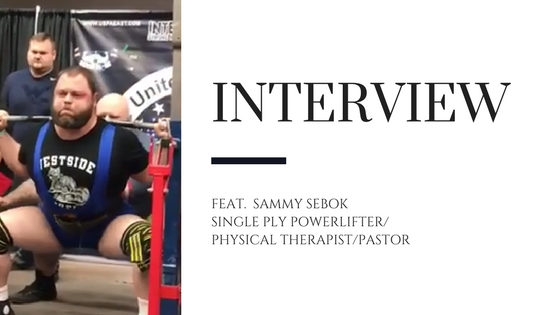Sammy Sebok has taken the term “Renaissance Man” to new heights. He’s juggling two careers that involve caring for people in addition to being a husband and powerlifting coach. That schedule hasn’t stopped him from being named Athlete of the Year by the Natural Athlete Strength Association (NASA) in 2016 achieving Single Ply meet lifts of SQ/755 BP/573 DL/639. Read on to learn about his training philosophy, learn some cool squatting cues and find out how to get your father-in-law to build a home gym for you!
First of all, as we’re doing this your wife Brittany is recovering from an emergency appendectomy. How is she doing now?
My wife is doing very well making a speedy recovery thanks so much for asking.
Glad to hear it! I have to say, I think your Instagram handle, The Iron Saint, is one of the best I’ve ever come across. Obviously, you’re a pastor and you obviously lift weights is that the origin of your name?
Being known as Iron Saint wasn’t my original intent. When I first started powerlifting the gym/team I was on was called Big Dogs. Following college I was the only one of us still actively lifting and had began training my brother in law. We were both Christians and been called to preach and so Iron Saints was the name we came up with to give our gym as we began competing together and people began to seek out training with us. Over time though it’s just become my identifier as so many times we meet people on IG before in person now.
You have a pretty good sense of humor, I loved that He-Man/Wonder Woman meme.
I love to joke and have a good time and to train with us you can’t have thin skin because we’re always giving each other a hard time. Gym motto is “Safety third and feelings last”.
Did watching 80’s cartoons influence your love of lifting weights?
Growing up in the 80’s definitely influenced how I viewed strength. I grew up watching/reading comics like He-Man, Superman, GI Joe, Thundercats, Ninja Turtles, Batman, hulk, the rocky movies etc. I always loved strength and wanted it. I feel this generation is missing out on stuff like that because those shows often had a moral lesson included so you learned strength was something used for good.
You played football. How long did you play and what position?
I began playing football in 7th grade and played all through Jr High and High school and 2 years in college. I also had a short stint with a semi pro team here in WV. I played a few different positions in 7-9th grade but what I mainly always played and stayed at in high school and beyond was inside line backer. I loved that position and playing in a 3-4 defense as I felt it allowed me to make plays all over the field.
How did you transition into single ply powerlifting?
John Cooper, the owner of my former gym, Big Dogs, which is a garage gym as well, began training me for football as a friend who had already graduated was lifting there and had told him I should get a invite to the gym. Once he was training me for football he told me they competed in powerlifting and while I didn’t have to if I wanted to I was welcome to do that as part of their team. It was spring of my Junior year of high school and following a football game my senior year I got up the next morning and went and competed in a bench only meet and was hooked. Back then there was no raw division everyone competed single ply. Some guys may have benched or deadlifted raw but there was no separate categories. This was in 99. The gear evolved and multi ply become the rage and now raw but I’ve always been at home chasing my single ply goals. I do wish to compete raw and multi ply at least once.
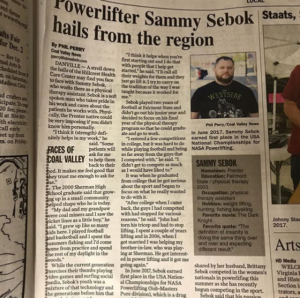 You’ve gotten some recognition already— you were the Natural Athlete Strength Association Athlete Of The Year in 2016 so your answer to this question will play a big role in whether or not this sees print. Were you even more excited about being featured on garagegymmagazine.com as you were for your 2017 feature in the Coal Valley News?
You’ve gotten some recognition already— you were the Natural Athlete Strength Association Athlete Of The Year in 2016 so your answer to this question will play a big role in whether or not this sees print. Were you even more excited about being featured on garagegymmagazine.com as you were for your 2017 feature in the Coal Valley News?
I was very humbled to be chosen as 2016 powerlifter of the year in NASA as well as being recognized by Coal Valley News but you know what they say you can’t be a prophet in your home town.
Well, the guy who said it has a track record of being right all of the time so there’s that.
Seriously, it meant a lot to be recognized by my home town paper but there are people who personally know me who kept putting my name into it so to be recognized nationally by you and NASA as a organization feels like a different level of accomplishment.
Seriously, being named Athlete of the Year by a federation like NASA that includes lifters like Dennis Cornelius is a pretty big deal! So many people want instafame; talk about how long it took for you to go from novice lifter to Athlete of the Year.
I began competing in 1999. I graduated from college in 2003 and shortly afterwards everyone I competed with no longer did. I never stopped training but didn’t compete again regularly until 2006-2007 probably. I finally won WV athlete of the year in 2010 getting to follow in John Cooper’s foot steps and then finally surpass him in 2016 with a national award. So 17 years of hard work. So many people are discouraged I feel because everyone focuses on the elite of the elite guys who show up and light the world on fire breaking ATWR in their 20’s. Consistency over a long period is what brings most people success.
You’re a husband, preacher and physical therapy assistant as well as a powerlifter and Patty Sebok is ready for you to become a father. How do you have enough hours in the day to train?
Taking on all my roles are hard and sometimes I don’t feel like I have enough hours in the day to do it all, but it’s like I’ve preached about before you have to be willing to make sacrifices. I have many things I want to do so I have to sacrifice to make it possible. It’s midnight right now. I’m getting up early to lift tomorrow on my first day off in eight days so I can be back in time to take Brittany to the doctor and spend time with her and this weekend when I go to help Mark at his meet I’ll be working on my outline to preach for Sunday. If you want to succeed at something you just make time for it plain and simple.
All kidding aside, simply having a home gym isn’t enough when you have that many things pulling at you— you need to be organized and consistent. What are some ways that you set up your day to stay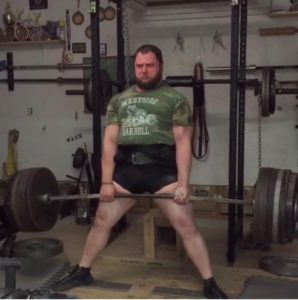 consistent with training?
consistent with training?
Recently my schedule changed at work and that has helped me. I work ten hour shifts but it’s four days on four days off; eight days on five days off. So on my days off, I usually try to train morning or mid-day depending on my training partner’s schedule. This allows me to catch up on sleep and other responsibilities as well as spend more time at home with my wife. On days I work and train it’s just caffeine, try to get to work at a decent time, and after main lift is done, no breaks push through the accessories with as little rest as possible.
Since you’re a physical therapy assistant, let’s dive into what role you see mobility work playing into longevity as a strength athlete. Also, how often do you do it and where do you place it in your training?
As a PTA, I think mobility work is crucial to staying healthy but at the same time some people take it over board. You don’t want to have restricted joints while loading yourself up with weights but you also don’t want to be loose and hypermobile.
Before we go on, I want to address this: I hear powerlifters talk about not wanting to be hypermobile but the average powerlifter can’t touch his or her toes. Our shoulders are so tight, a lot of us need to wear elbow braces to ease the pain from setting up for a low bar squat. I used to be like that definitely! So hypermobility seems to be most remote possibility in their world. If anything, I think yoga practitioners need to worry about hypermobility more than someone in a strength sport like powerlifting. What are your thoughts about that?
I totally agree more powerlifters could use some more mobility as many don’t have normal range of motion. I’ve made sure to maintain normal range of motion limits and feel I’m much healthier for it than most. It makes my brain hurt when on social media I see guys complaining of elbow pain and all the advice guys are giving is just Band Aid stuff. It’s always something like rub this on it, wear this cuff, and move your squat and bench days further apart. How about fix your shoulder rotation and thoracic mobility? On the other hand, I see a trend of young powerlifters foam rolling and stretching for a hour before ever touching a weight! It’s a waste of time and counter productive. You want your muscles to be warm with good blow flow but ready to be handle a load not ready to relax under it.
I am by no means anti-stretching but do it with a purpose. Do your tempering and mobilization work to areas that need it; not everywhere just because. Also, mobilizing a tissue or joints is different than just stretching it a bunch and I feel safer and more beneficial to do that prior to a lift.
I agree, my total warm up takes about six minutes from the time the foam roller comes out to when I finish doing my crawls and rolling and get under a bar. I don’t see any reason to take longer than that because you’re going to do a movement specific warm up just by doing warm up sets in the lift anyway!
I have some things I do every day before I lift that I feel help keep me healthy. It’s Stuart McGill Big 3 and Donnie Thompson’s low back protocol. I usually do the low back protocol to decompress my spine and get my hips to relax so there’s no muscles in my hips trying to do a job it’s not supposed to or restricting my movement, next is the McGill Big 3 to improve my body’s ability to create overall tightness and brace my spine. After that it’s light weight movements to get blood flow to all the involved muscles of the day before finally starting with a empty bar for a set of twenty. I also do hip abductor/adductor work followed by stretching for any tight muscles the day after my lower body days.
How did you decide where to put your mobility work?
I feel it just irritates any problem areas stretching them as soon as I’m done when it comes to lower body, but upper body I can stretch immediately following without problems. I also recommend doing YTWL’s the day after a upper body session for shoulder health and active recovery.
I’ve heard from some older powerlifters that you shouldn’t train the same day that you go to a chiropractor or soft tissue specialist because you’ll be weaker but my soft tissue specialist is of the opinion that you feel weaker because getting soft tissue work or an adjustment gives you a new range of motion and your body isn’t used to it yet. She believes that you should train as soon as you can after an adjustment so your body not only learns to hold that improved range of motion but also so you get stronger there as well. What’s your take on it?
I think it depends on what you had done and what you’re doing lifting wise. I’ve had dry needling done, which I highly recommend, and lifted following that with great results.
Little Secret: dry needling to the lower back is like the contra cheat code for immediate increase in ab strength. Everyone is different though and I think you should listen to your body. If you have some chiropractic adjustments done and feel weak and it’s supposed to be a heavy day don’t risk injury. Maybe do some light weight to work your new movement and move the intended session back a day. I don’t recommend tons of foam rolling and stretching before lifting though as you’re telling a muscle to relax that you need to be tight to hold a load. It lowers its natural ability to protect itself from over-stretching.
Let’s segue into your garage gym. Tell me what you started your gym with, how long you went before you added anything and what that first addition was.
So the thing about Iron Saint’s Gym is it’s my father-in-law Jeff Howerton’s garage, ha ha! When I first met them it was to train my future brother-in-law, Zach, for football as he was going into Junior High. The gym originally was just a room in the house with a half rack with cable attachment on the back with high and low pulley, a flat/incline/decline bench, plates, and dumbbells. Since I had no one to train with, I trained with Zach and began bringing my own bands and chains etc. to the gym. I made the same deal with Zach that John made with me in that if he ever wanted to compete in powerlifting as well I’d help him. In no time, Zach was competing and went on to earn a football scholarship. Eventually a competition bench from Elite was the next addition to the gym as a birthday present, followed by a Bamboo Bar later. By this time Brittany and I were married and our lifting was far outgrowing a room in the house so my father in law decided to build us a garage gym and put a R3 westside rack from Rogue in it, per my recommendations, so we could safely squat and deadlift. Some time after that John who I started with decided to sell his gym equipment and offered it to us first and we jumped on the deal. We expanded our dumbbells and plates as well as getting more bars and a leg press/hack squat. During that time my current training partner Mark Jarrell started lifting with us and together we have expanded getting multiple specialty bars, a back extension, and a homemade stand for belt squats. My father-in-law also got us the rogue westside monster bench probably a year ago. Yes, my father-in-law is better than yours people reading this!
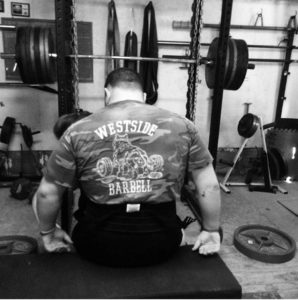
So what I got from this is, Zach invited you over to train with him and you not only put the moves on his sister but somehow convinced their dad to build you a homegym. You’ve got me looking closely at this one kid from the neighborhood who trains with me. My daughter’s only two but she’ll be interested in boys by middle school so I’ve got to make sure we’ve got a no boys allowed policy in place by then. Nobody’s going to steal my little girl away and have me spend my retirement money on a gym for them ha ha!
The story behind Britt and I getting together is I was called by her parents to train Zach. A girl that was friends with my younger brother recommended me because I had played college football and my brother and I both competed in powerlifting. They knew Zach had potential for a scholarship but in a small town like ours the kind of people who can help train for something like that are minuscule. I didn’t know it but she had already had ideas of Brittany and I being a couple. I was not a Christian at the time so the idea of dating a preacher’s daughter sounded crazy to me and I paid it no mind. After a week or two of training Zach, Brittany walked into the gym one day and asked if I would like to go to the movies. I found out later her mother told her if she didn’t go ask me out she was going to ask me for her ha ha! It worked out because I really enjoyed being out with despite her terrible movie choice ha, ha! After that I continued to take her out and Zach’s training quickly became free!
Matchmaking at it’s finest! Ha! Okay, back to work! So who are your top go to sources for equipment? You need X piece of equipment, do you try to build it first, hit up Craigslist or OfferUP or do you try to go new first? I know you’re a fan of EliteFTS and Rogue Fitness, how much of your gym is outfitted with their stuff?
My go to places if I’m looking for something big equipment wise is EliteFTS and Rogue but sometimes we also find equipment for sale via social media, Amazon etc. We also build less complicated things like our boxes for box squats, boards, deadlift blocks, and a stand for belt squats. Elite has been our supplier of bands, chains, slingshots, fat grips, safety squat bar, Texas squat bar, bamboo bar, and a competition bench. Almost everything in the gym except what we got from John and the power rack and other competition bench has came from them.
What else is on your wishlist as far as equipment?
If I could have anything would be a reverse hyper ha ha! If I’m being realistic with the space we have and financially I’d like to get one of Brian Schwab’s Home Glute/Ham Raises. I’ve actually used one at his gym. I’ve been there a few times on vacation and got to lift with him and Jo Jordan. They’re good guys.
Well done on giving me an internal hyperlink! With no rehearsal either! Seriously, I’m a huge fan of the Home GHR. As I said on Instagram, when promoting the article we did with Brian on it, I’ve owned mine for several years and I’m extremely pleased with the results I’ve gotten from it. It’s so user friendly, I tell people to buy it so much it’s like I get paid to promote it. (I don’t.)
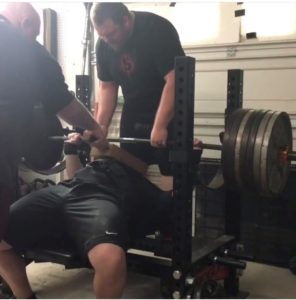 When you train in gear, it’s not easy to train alone. You sometimes need help getting in and out of your suit or shirt. Your wife is a powerlifter and she trains with you; plus I see a few guys in your social media pics and videos. How many people do you train with at your home gym on a regular basis?
When you train in gear, it’s not easy to train alone. You sometimes need help getting in and out of your suit or shirt. Your wife is a powerlifter and she trains with you; plus I see a few guys in your social media pics and videos. How many people do you train with at your home gym on a regular basis?
It’s definitely not easy to train in gear alone that’s why I have a Yeti/Sasquatch aka Mark Jarrell. We always train together for heavy days but sometimes do lighter sessions on our own if something is going on. The other gym you see in my Instagram videos is in a friend’s basement. It’s called Logan County Barbell. My wife trains there with our mutual friends/family Kayla and Craig. We also have a new guy lifting with us some as well as my brother-in-law Zach and a friend, Jake Robinson, who’s making a comeback.
Do you guys travel to meets together?
We all travel and compete together but never Mark and I at the same meet because it was just too difficult when we tried it. Everyone else lifts raw so it’s much easier for them to lift and help each other.
Let’s talk training. Your squat form is in your words, spot on recently. You told @jonzillo and now I want to know too. What things have you been focusing on?
Man! You’re wanting secret squat intel, ha ha! The thing I’ve been working on is feet and ankle strength/health. Working to make arches strong and bring more balance to the strength of my ankle joint working supination and dorsiflexion. I also changed the way I approach my feet with squat. You hear screw your feet into the floor and before I was creating the tension in my feet with my hips and legs. Now I’m making sure to really press my toes into the floor and try to turn and spread the floor with my actual foot. It’s lead to a much improved position and hips feeling better.
That’s an interesting point. I think we’re going to need a video of that. So now you can tell your wife that she needs to do a video of your bare feet. I know that’s a lifelong dream of hers so there you go Brittany!
You said you’re trying to catch your training partner, Mark Jarrell on bench and overall total. You already covered the squat. What things are you adjusting in bench and deadlift to help you get where you want to be?
The main thing with catching Mark is to just stay consistent and keep working. My bench is strong but I have to find the right balance for it to peak just right. For deadlift, my hips are feeling great so I just have to cement my technique and keep working on my back strength. I had a problem with a hip rotator strain and it messed my form up so it’s been a bit of re-learning things.
You’re a conjugate style lifter, do you have certain accessories you tend to use for longer cycles or do you have training blocks set in stone where you know you’re switching things up regardless of how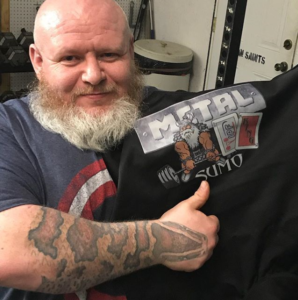 training is going just so you don’t become an expert at block pulls for example but not at the actual competition lift?
training is going just so you don’t become an expert at block pulls for example but not at the actual competition lift?
The best thing about conjugate style training is also what people struggle with the most and that it’s completely customizable to your needs. I have a base outline I follow because I’ve been training like this long enough to know my needs but if at anytime I realize I need to work on something I can make a change. I always keep in back extensions, good mornings, and stiff leg rack pulls in for squat/DL training to ensure my back strength is where it needs to be.
To go along with that, how often do you need to train the competition version of the three lifts in order to be ready on meet day?
I think this is something people overthink a lot. No matter what bar or resistance you use a squat is still a squat, a bench is still a bench, and a deadlift is still a deadlift. Unless you’re just choosing some crazy variations that completely distort the lift from what it’s like in your chosen venue be that raw, single ply or multi-ply, then it shouldn’t be a problem. If I’m not close to a meet, I alternate raw free squat variations with box squats in the suit with my straps down. Once I start training for a meet raw squats are gone after about 3 weeks in and I just train in the suit ,straps down, with box squats. I use full gear free squats for my last 3 heavy squats of a meet cycle and it never feels foreign. When it comes to bench I always train in my shirt once a month. Deadlift I alternate conventional raw variations and sumo variations in gear. As I get closer to a meet I do more sumo variations from the floor and off blocks to overload. I pull a opener about a month out and after that I just have one week pulling 80% of my predicted 3rd attempt.
A lot of people set training aside when lift happens, for example, the situation with your wife— you not only woke up at 3:45am to train before the surgery but got right back at it as soon as you saw that she was doing well. That’s the sort of dedication that leads to being named NASA Athlete of the Year. We touched on this earlier but go a little deeper into how you balance life, family plus your responsibilities as a preacher?
I actually was up at that time the day after Brittany’s surgery. Once I found out she was having surgery I left work and didn’t leave the her side until I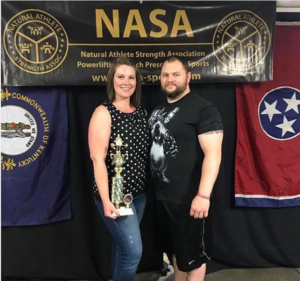 had to for the surgery and then to come home and sleep. I didn’t lift that day so I got up early that morning to lift before work so when she was discharged I could come straight home and be with her. If you start putting things on hold every time something comes up; you’ll start looking for reasons not to train instead of trying to find ways to make it possible to fit your sessions into whatever is going on. That’s the way I balance things— I make my lifting fit in around family time. My responsibilities with church services are on Wednesday and Sunday which are rest days for me. I just have to start preparing sermons and lessons in advance, piece by piece. In the age of technology it’s easier because I can do this anytime and anywhere something hits me.
had to for the surgery and then to come home and sleep. I didn’t lift that day so I got up early that morning to lift before work so when she was discharged I could come straight home and be with her. If you start putting things on hold every time something comes up; you’ll start looking for reasons not to train instead of trying to find ways to make it possible to fit your sessions into whatever is going on. That’s the way I balance things— I make my lifting fit in around family time. My responsibilities with church services are on Wednesday and Sunday which are rest days for me. I just have to start preparing sermons and lessons in advance, piece by piece. In the age of technology it’s easier because I can do this anytime and anywhere something hits me.
I saw you throw your hat into the ring to become a sponsored athlete with GCode Nutrition. I’ve known Greg Santarsiero for a few years, in fact he’s a home gym owner himself and we profiled his company a few months ago. Best of luck to you with that first of all. You’re already seeing success in your chosen sport. What do you hope being a sponsored athlete will do for you as a strength athlete?
I chose to put my name out there for the G Code sponsorship because they’re a good company and I wanted to bring attention to them whether I won or not. Too many supplement companies now spend more money on labels and marketing than making actual quality supplements. If I won obviously quality supplements are a benefit to aid training. It would help relieve some expenses in a sport that only the athletes don’t benefit from financially. But the main thing I think it would accomplish for me is to give me a bigger platform to help people. John Cooper helped me for free and told me to make others better than myself. I feel when a quality company backs you people view you differently and begin to seek you out that would have dismissed you before.
Well said. I appreciate you sharing your story with us Sammy! Where can people follow you if they want to learn more about your training or just follow your iron journey?
My Instagram is the best place for people to follow or reach out to me. @ironsaint_sebok

